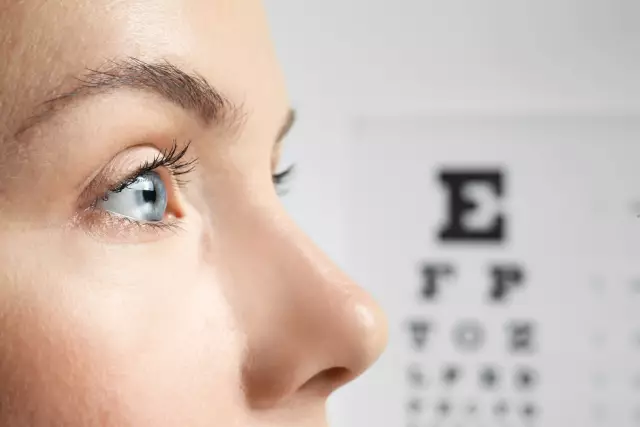- Author Rachel Wainwright [email protected].
- Public 2023-12-15 07:39.
- Last modified 2025-11-02 20:14.
Leukoplakia
The content of the article:
- Causes and risk factors
- Forms of the disease
- Symptoms of leukoplakia
- Diagnostics
- Leukoplakia treatment
- Possible complications and consequences
- Forecast
- Prevention
Leukoplakia is a lesion of the mucous membranes, characterized by focal keratinization of the integumentary epithelium of varying severity. Only mucous membranes lined with stratified squamous or transitional epithelium are affected. The pathological process can develop in the oral cavity, respiratory tract, genitourinary organs, in the anal area.

Source: stomatolab.com
The white or grayish-white color of leukoplakia foci is due to the keratin content in the keratinized epithelium. Leukoplakia is capable of malignant transformation (in 3-20% of cases), and therefore refers to precancerous conditions. Most often it is diagnosed in middle-aged and elderly people. So, leukoplakia of the cervix is more common in women over 40 and reaches 6% of all pathologies of the cervix.
Most often, leukoplakia is diagnosed in males, children and adolescents are less prone to it than adults.
Causes and risk factors
The mechanism of the formation of leukoplakia is not fully understood. It has been established that an important role is played by the effect on the mucous membranes of unfavorable external factors (mechanical, thermal, chemical irritation and their combinations).
Risk factors include:
- genetic predisposition;
- diseases of the gastrointestinal tract (determined in about 90% of cases);
- inflammatory and neurodystrophic changes in the mucous membranes;
- immunodeficiency states;
- metabolic disorder or vitamin A deficiency;
- changes in hormonal levels;
- history of diathermocoagulation;
- presence of occupational hazards (work with coal tar, pitch, etc.);
- poorly fitted fillings, dentures, as well as dentures made of different metals (mechanical injury to the mucous membrane and exposure to galvanic currents);
- bad habits (the combination of thermal and chemical exposure when smoking is especially dangerous);
- excessive sun exposure;
- unfavorable ecological situation;
- the use of low-quality food and drinking water.
Forms of the disease
Depending on the morphological features, the following forms are distinguished:
- simple leukoplakia (flat);
- verrucous leukoplakia (warty);
- erosive leukoplakia;
- smokers leukoplakia.

An atypical type of pathology is hairy leukoplakia, which develops only in patients with severe immunodeficiency, in particular, in people with AIDS-associated symptom complex, as well as those taking long-term immunosuppressive drugs.
Symptoms of leukoplakia
Most often, the pathological process develops on the mucous membrane of the inner surface of the cheeks, lower lip, in the corners of the mouth. Less commonly, the lateral surface and back of the tongue, the area of the bottom of the oral cavity, the alveolar process, the vagina, the vulva, the clitoris, the glans penis, the anus, and the bladder are affected. Leukoplakia of the mucous membrane of the respiratory tract often occurs in the epiglottis and vocal cords, less often the lesion is localized in the lower larynx.
The main symptom is the appearance of a flat, rough, whitish spot (leukoplakia in Latin means "white plate") on the mucous membrane. Other clinical signs of leukoplakia depend on its form.
With flat leukoplakia, there is a sharply delimited continuous opacity of the mucous membrane, which resembles a film, is not removed by scraping with a spatula, painlessly, accompanied by a feeling of contraction. The color of the affected area varies depending on the intensity of keratinization from pale gray to white, it can become opalescent, the surface of the affected area is dry and rough (sometimes takes on a wrinkled or folded appearance). The focus of leukoplakia often has a jagged shape, while there is no compaction at the base of keratinization. On the periphery of the affected area, slight hyperemia may be observed.
With the verrucous form of leukoplakia, smooth milky-white plaques usually appear on the mucous membrane, towering above the surface of the mucous membrane (translated from Latin verruca - wart). Plaque formation occurs over several weeks or months. The lesions are usually painless, but they can be sensitive to palpation, react to hot, spicy food or other chemical, thermal, and mechanical stimuli. In some cases, there are lumpy, warty growths of a grayish-white color.
Erosive leukoplakia is characterized by the formation of cracks and erosions of various shapes and sizes on the affected mucous membranes, which is accompanied by pain.
Against the background of the existing flat leukoplakia, verrucous and erosive can develop. At the same time, at the initial stage of the pathological process, a slight inflammation usually occurs, then keratinization of the epithelium of the inflamed area occurs, the lesion becomes denser, rises above the surface of the mucous membrane and ulcerates.
In the case of smokers' leukoplakia, there is continuous keratinization of the hard palate and adjacent areas of the soft palate. Affected mucous membranes acquire a grayish-white tint, against which red dots are visible (gaping mouths of the excretory ducts of small salivary glands).
Symptoms of laryngeal leukoplakia are dry cough, hoarseness, discomfort during conversation.
Leukoplakia of the bladder is manifested by dull pain in the lower abdomen and perineum, itching, cramps, and discomfort when urinating. With leukoplakia of the scaphoid fossa of the urethra, difficulty urinating appears.
All forms are prone to malignancy, while malignancy of the leukoplakia of the tongue is most often observed. Signs of malignant transformation of flat leukoplakia include the sudden onset of erosions or seals in the leukoplakia focus, as well as uneven compaction on one side of the focus. Compaction in the center of erosion, a sharp increase in erosion in size, ulceration of the surface of the lesion, papillary growths may indicate a malignant transformation of erosive leukoplakia.
Diagnostics
Diagnosis of leukoplakia is based on data obtained during an objective examination. Often, pathology is an accidental finding during a dental or gynecological examination, colposcopy, etc.
To confirm the diagnosis, a biopsy is performed, followed by cytological and histological examination of the material in the laboratory. Cytological examination makes it possible to detect cellular atypia, which is characteristic of precancers. In the lesion focus, a large number of epithelial cells with signs of keratinization are detected; atypical cells from the layers below can also be found. In the course of histological analysis, keratinizing epithelium is found, which does not have a superficial functional layer (the upper layers of the epithelium are in a state of para- or hyperkeratosis). The risk of malignant transformation is evidenced by atypia of basal cells of varying degrees and basal cell hyperactivity. In the presence of severe atypia, the patient is referred for a consultation with an oncologist.

Source: medweb.ru
During the diagnosis of leukoplakia, a general urine test, a bacteriological urine test, a general and biochemical blood test, an immunogram, a study for the presence of sexually transmitted infections (bacterial scraping, PCR, etc.) are also carried out.
If laryngeal leukoplakia is suspected, laryngoscopy is indicated, in the case of leukoplakia of the urethra or bladder - urethroscopy and cystoscopy, respectively. To confirm the diagnosis, an ultrasound examination of the uterus and appendages, and the bladder may be needed.
Differential diagnosis is carried out with lichen planus, candidiasis, Darier's disease, secondary syphilis, Keir's disease, Bowen's disease, keratinizing squamous cell carcinoma of the skin.
Leukoplakia treatment
The condition for effective treatment of leukoplakia is the elimination of the traumatic factor that caused its development.
Simple leukoplakia without signs of cellular atypia usually does not require radical therapeutic measures, it is enough to eliminate the traumatic factor (treatment or removal of decayed teeth, replacement or fitting of fillings and prostheses, etc.) and expectant tactics.
The presence of cellular atypia and basal cell hyperactivity is an indication for the removal of the leukoplakia focus.
Removal of the affected areas of the mucous membrane can be carried out using a laser, diathermocoagulation, electro-excision, radio wave method. Coagulation of leukoplakia foci with liquid nitrogen leaves rough scars, therefore cryodestruction in leukoplakia is of limited use.
With leukoplakia of the larynx, they resort to minimally invasive endoscopic surgery. Bladder leukoplakia is also treated surgically with cystoscopy. In addition, removal of the lesion in the bladder can be carried out by injecting gaseous ozone, ozonized oil or liquid into the bladder.

Source: likar.info
In some cases, surgical excision is required not only of the mucous membrane, but also of the entire affected area (partial resection of the urethra, bladder, vagina).
Drug therapy consists in taking anti-inflammatory (usually steroid) drugs, vitamins (vitamin A). When a secondary infection is attached, anti-infectious (antibacterial, antimycotic) drugs are prescribed.
Possible complications and consequences
A dangerous complication of leukoplakia is its malignant transformation. Verrucous and erosive forms have the greatest potential for malignancy.
Against the background of leukoplakia of the mucous membrane of the cervix, infertility may develop. The lack of timely adequate treatment of leukoplakia of the mucous membranes of the larynx leads to the formation of irreversible changes in the tissues of the larynx, as well as the more frequent occurrence of ENT pathology in the patient.
Leukoplakia of the bladder in the absence of treatment significantly reduces the quality of life, serving as a source of constant discomfort.
Forecast
With timely treatment, the prognosis is favorable, however, patients are shown dispensary observation in order to avoid relapses of pathology. With the development of complications, the prognosis worsens.
Prevention
In order to prevent leukoplakia, it is recommended:
- timely treatment of dental diseases, planned rehabilitation of the oral cavity, high-quality prosthetics, quick elimination of factors injuring the mucous membrane;
- rejection of bad habits;
- balanced diet;
- avoidance of overheating, hypothermia and other adverse effects on the body of environmental factors;
- avoidance of occupational hazards.
YouTube video related to the article:

Anna Aksenova Medical journalist About the author
Education: 2004-2007 "First Kiev Medical College" specialty "Laboratory Diagnostics".
The information is generalized and provided for informational purposes only. At the first sign of illness, see your doctor. Self-medication is hazardous to health!






